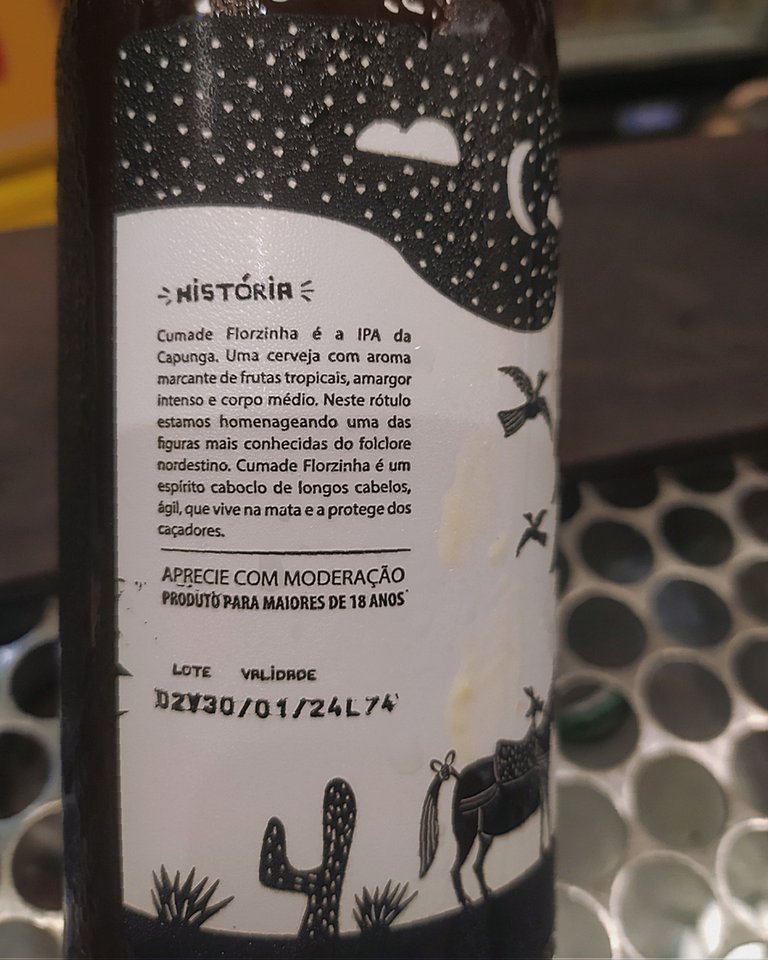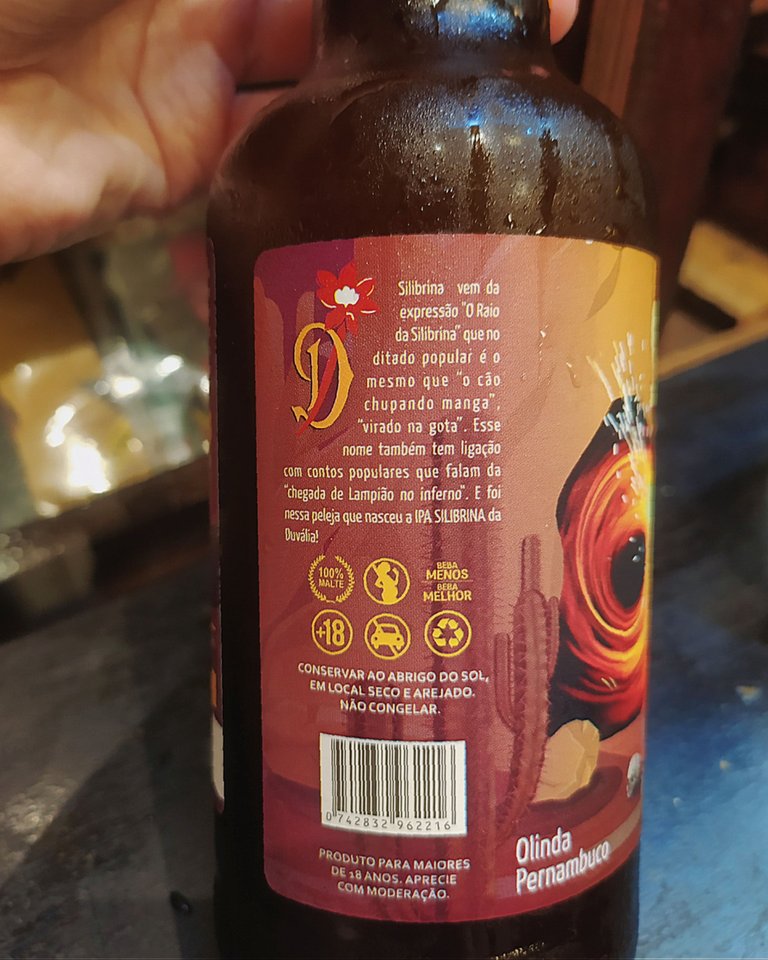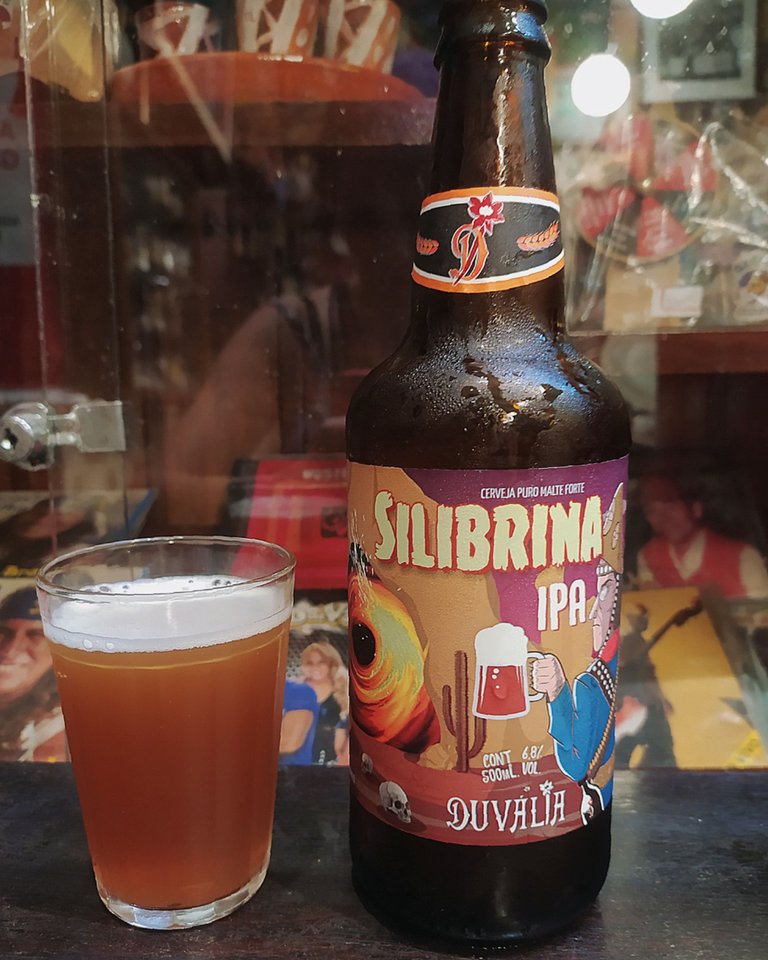Beereview – "Capunga", "Duvália" and "DeBron" [ENG/ESP]
Greetings! How's it going? I hope you guys are doing great.
Well, since I don't post here that often – I swear I'm trying to change that – I ended up putting off this review. Actually I took this trip a while ago, I went to Rio Grande do Norte first, then made my way down to the state of Pernambuco – you can check out my Rio Grande do Norte trip reviews here and here.
I had to adjust the schedule of this trip so I ended up going to Recife, Pernambuco's capital city, to catch my flight back home. And since Recife and Olinda are basically neighbors, I spent one night and one day in Olinda. I know, that wasn't even close to enough time to explore the city the way it deserves, but still, I got a little taste Pernambuco vibe – and by that I mean drinking some local craft beers, of course.
Versión en español¡Hola! ¿Qué tal todo? Espero que estén muy bien.
Bueno, como no publico aquí con tanta frecuencia – lo juro, estoy intentando cambiar eso – terminé dejando esta reseña para después. En realidad hice este viaje hace un buen tiempo. Primero fui a Rio Grande do Norte y luego bajé hasta el estado de Pernambuco – pueden ver mis reseñas del viaje a Rio Grande do Norte aquí y aquí.
Tuve que ajustar el itinerario de este viaje, así que terminé yendo a Recife, la capital de Pernambuco, para tomar mi vuelo de regreso a casa. Y como Recife y Olinda están prácticamente una al lado de la otra, pasé una noche y un día en Olinda. Ya sé que no fue ni de cerca suficiente para explorar la ciudad como se merece, pero aun así pude saborear un poquito de la vibe pernambucana – y con eso me refiero, por supuesto, a probar algunas cervezas artesanales locales.

For those who don't know, Olinda is known for its colonial houses, hilly cobblestone streets, and, of course, its unique Carnaval. In fact, the festivities were just starting when I was leaving – worst timing ever, but I'll definitely go back one day, at the right time. During my short stay, I ended up at a traditional spot called Bodega de Véio – it's a classic boteco that is a mix between an old-school grocery store and a bar. I had three local IPAs there – funny thing is, I didn't plan on drinking only IPAs, it just happened that the labels that caught my eye in the fridge were all IPAs, heh.
Versión en españolPara quienes no lo saben, Olinda es conocida por sus casas coloniales, sus calles empedradas y con subidas, y, por supuesto, su Carnaval tan único. De hecho, las festividades estaban comenzando justo cuando me iba – el peor timing del mundo, pero sin duda volveré algún día, en el momento correcto. Durante mi corta estadía, terminé en un lugar tradicional llamado Bodega de Véio – es un Bodega de Véio – it's a classic boteco clásico, una mezcla entre una antigua tienda de abarrotes y un bar. Ahí probé tres IPAs locales – lo curioso es que no planeaba tomar solo IPAs, simplemente sucedió que las etiquetas que más me llamaron la atención en la nevera eran todas de IPAs, jeje.


Let's start with the first beer of the night: Capunga's Cumade Florzinha. Founded in 2015, Capunga is a craft brewery from Pernambuco, located in the city of Igarassu, in Recife's metropolitan region. I had no idea what "Capunga" meant – never even heard the word before – so, according to Mr. Google, Capunga is the name of a bridge in Recife, near where the first brewery in the American continent was established, back in 1640 by a Dutch brewmaster named Dirck Dicx. Cool, isn't it?
Well, not just the brewery's name caught my attention but the curious beer name and, especially, the label art, made in woodcut style as the illustrations in cordel literature were done. The name Cumade Florzinha comes from the northeastern Brazilian folklore, it's known as a forest spirit who protects the woods from hunters.
Versión en españolEmpecemos con la primera cerveza de la noche: Cumade Florzinha de Capunga. Fundada en 2015, Capunga es una cervecería artesanal de Pernambuco, ubicada en la ciudad de Igarassu, en la región metropolitana de Recife. No tenía ni idea de qué significaba “Capunga” – ni siquiera había escuchado esa palabra antes – así que, según señor Google, Capunga es el nombre de un puente en Recife, cerca de donde se estableció la primera cervecería del continente americano, allá por 1640, por un maestro cervecero holandés llamado Dirck Dicx. ¿Genial, no?
Bueno, no solo el nombre de la cervecería me llamó la atención, sino también el nombre curioso de la cerveza y, especialmente, el arte de la etiqueta, hecho en estilo xilografía, como las ilustraciones de la literatura de cordel. El nombre Cumade Florzinha viene del folclore del noreste brasileño, es conocida como un espíritu del bosque que protege la naturaleza de los cazadores.


Now talking about the beer, Cumade Florzinha is an American IPA, with an ABV of 6% and 54 IBU. I paid around $15 for a 600ml bottle ($2.65 USD, approximately). When poured, it showed a slightly hazy amber color with bubbly white foam that didn't last long. Unfortunately the only glass available at the bar was the classic "Brazilian glass" – which we call "American glass" over here, heh – so I guess the foam didn't behave the way it was supposed to.
The aroma was subtle – mostly herbal, piney, and a bit floral. In the mouth, the bitterness felt moderate for its IBU, as the malts balanced it out quite well. There was also a citrusy note, reminiscent of passion fruit. The herbal character carried through from the aroma, and after a few more sips I started to pick up a hint of malt sweetness in the aftertaste. Still, the herbal side of it might've been a bit too dominant – I couldn't really figure out more than that, so I'd say it lacked some complexity. It had medium carbonation, a medium-to-light body, and a nice dry finish.
Versión en españolAhora hablemos de la cerveza, Cumade Florzinha es una American IPA, con un ABV del 6% y 54 IBU. Pagué unos $15 BRL por una botella de 600 ml ($2.65 USD, aproximadamente). Al servirla, presentaba un color ámbar ligeramente turbio con una espuma blanca y burbujeante que no duró mucho. Lamentablemente, el único vaso disponible en el bar era el clásico "vaso brasileño" – que por aquí llamamos "vaso americano", jeje – así que supongo que la espuma no se comportó como debía.
El aroma era sutil – principalmente herbal, con notas de pino y un toque floral. En boca, el amargor se sintió moderado para los IBU, ya que las maltas lo equilibraban bastante bien. También había una nota cítrica que recordaba al maracuyá. El carácter herbal se mantenía desde el aroma, y después de varios sorbos empecé a notar un leve dulzor de malta en el retrogusto. Aun así, el lado herbal tal vez fue demasiado dominante – no logré percibir mucho más allá de eso, así que diría que le faltó algo de complejidad. Tenía una carbonatación media, cuerpo entre ligero y medio, y un final seco agradable.


So, the next beer I had that day was (spoiler: my favorite among them) Duvália Silibrina IPA. The brewery is from Olinda, founded in 2013. Its name comes from the street's name where the founders grew up.
Like the previous one, the label design was the first thing that caught my attention: it has a drawing of Lampião, a famous folk bandit from the Northeast and a legendary figure in Brazilian history. The artwork actually shows a scene of Lampião arriving in hell, which explains the drawing that looks like a flaming black hole. According to the label, that's where the beer's name comes from: "Silibrina" is part of the popular expression "o raio da silibrina" – basically the same vibe as "o cão chupando manga", both used to describe someone or something wild and chaotic. The former has a bunch of other meanings too, but I won't get into that here. Yeah, Brazilian Portuguese is no joke, heh.
Versión en españolLa siguiente cerveza que tomé ese día fue (spoiler: mi favorita entre todas) Duvália Silibrina IPA. La cervecería es de Olinda y fue fundada en 2013. Su nombre viene de la calle donde crecieron los fundadores.
Al igual que con la anterior, lo primero que me llamó la atención fue el diseño de la etiqueta: tiene un dibujo de Lampião, un famoso cangaceiro del noreste y una figura legendaria de la historia brasileña. La ilustración en realidad representa una escena de Lampião llegando al infierno, lo que explica el dibujo que parece un agujero negro en llamas. Según la etiqueta, de ahí viene el nombre de la cerveza: "Silibrina" forma parte de la expresión popular "o raio da silibrina", que básicamente transmite la misma idea que "o cão chupando manga", ambas se usan para describir algo o alguien caótico y descontrolado. La primera tiene un montón de otros significados también, pero no voy a entrar en eso aquí. Sí, el portugués brasileño no es cosa poca, jeje.


Back to the beer, Silibrina is an American IPA with 6.8% ABV and 64 IBU. I paid around $16 BRL for the 500 ml bottle ($2.83 USD, approximately). Its color is something else: a dark coppery amber, cloudy, with a pale beige that didn't hold up much – due to the glass – but it seemed somewhat persistent at first. The label says this beer went through a dry-hopping process with Equinox hops, still, I didn't get much citrus in the aroma – it was more on the resinous and herbal side, with a strong malt presence.
The malt on the palate really took the spotlight – but it didn't overshadow the hops completely. It managed to balance them out and even push through a little, I'd say. Maybe that's why I liked it so much – it's not every day you find a sweet IPA like this one, heh. Besides the honey-like malt flavor, I also picked up the same herbal notes from the aroma, along with some fruity hints. It had a creamy, medium-to-full body and medium carbonation. The drinkability is pretty high – that is, if you enjoy a more “unusual” kind of IPA. It was so good I ended up ordering another one right after.
Versión en españolVolviendo a la cerveza, Silibrina es una IPA americana con 6.8% de ABV y 64 IBU. Pagué unos $16 BRL por la botella de 500 ml ($2.83 USD, aproximadamente). Su color es maravilloso: un ámbar cobrizo oscuro, turbio, con una espuma beige pálida que no duró mucho – por culpa del vaso – aunque al principio parecía más persistente. En la etiqueta dice que esta cerveza pasó por un proceso de dry hopping con lúpulo Equinox, pero aun así no noté muchos cítricos en el aroma – era más resinoso y herbal, con una fuerte presencia de malta.
En boca, la malta fue la protagonista – pero sin dejar de lado los lúpulos. Logró equilibrarlos y hasta sobresalir un poco, diría yo. Tal vez por eso me gustó tanto – no todos los días se encuentra una IPA dulce como esta, jeje. Además del sabor a malta tipo miel, también sentí esas notas herbales del aroma, junto con algunos toques frutales. Tiene un cuerpo cremoso, de medio a alto, y carbonatación media. La tomabilidad es bastante alta – eso sí, para los que les gustan las IPAs un poco "diferentes". Estaba tan rica que pedí otra enseguida.


By the time I ordered the last beer of the night – DeBron IPA – I was already a bit tipsy, so I can't really remember what led me to pick it. Maybe it was the bartender's suggestion? Either way, it turned out to be a good choice, as it had the highest IBU among the ones I tried before. By the way, it's clear I wasn't exactly sober – I didn't follow my usual photo routine and ended up taking just one picture of the front label. Well, at least I could understand my notes from that night, haha.
DeBron Bier was founded in 2015 in Jaboatão dos Guararapes, right next to Recife. This brewery, as well as the first one I mentioned here, Capunga, were inspired by the first brewery in the American continent, whose name was "La Fontaine" – so "de bron" is nothing less than "the fountain", in Dutch.
So, DeBron IPA has 6.5% ABV and 70 IBU. I paid about the same price as the other two – around $15 and $16 BRL ($2.83 USD, approximately) for the 500 ml bottle. Its color is similar to Silibrina, but it's less cloudy and more brilliant, with light beige foam of low duration. The aroma was hoppier this time, with citrus fruits such as tangerine and lemon standing out, along with some floral notes. That carried over into the taste as well, with the resinous character of the hops coming through more strongly – maybe even bringing out the alcohol a bit more than in the previous beers. The resiny profile persists in the aftertaste, leaving a slight astringency. It's a good IPA, though – lighter in body than the previous one and slightly more carbonated. I'd definitely have another if this had been my first beer of the night.
Versión en españolCuando pedí la última cerveza de la noche – DeBron IPA – ya estaba un poco alegre, así que no recuerdo muy bien por qué la elegí. ¿Quizás fue recomendación del barman? Sea como sea, terminó siendo una buena elección, ya que tenía el IBU más alto de todas las que probé antes. Por cierto, está claro que no estaba muy sobria – no seguí mi rutina de fotos y terminé sacando solo una, de la etiqueta frontal. Bueno, al menos logré entender mis apuntes de esa noche, jaja.
DeBron Bier fue fundada en 2015 en Jaboatão dos Guararapes, al lado de Recife. Esta cervecería, al igual que la primera que mencioné aquí, Capunga, se inspiró en la primera cervecería del continente americano, que se llamaba "La Fontaine" – por eso "de bron" significa justamente "la fuente", en neerlandés.
DeBron IPA tiene 6.5% de ABV y 70 IBU. Pagué más o menos lo mismo que por las otras dos – unos $15 o $16 BRL (2.83 USD, aproximadamente) por la botella de 500 ml. Su color es parecido al de la Silibrina, pero menos turbia y más brillante, con espuma beige clara de poca duración. El aroma era más lupulado esta vez, con frutas cítricas como mandarina y limón destacando, además de algunas notas florales. Eso se notaba también en el sabor, con el carácter resinoso del lúpulo apareciendo con más fuerza – incluso resaltando un poco más el alcohol que en las cervezas anteriores. El perfil resinoso persiste en el retrogusto, dejando una ligera astringencia. Aun así, es una buena IPA – de cuerpo más ligero que la anterior y un poco más carbonatada. Definitivamente me tomaría otra si esta hubiera sido mi primera cerveza de la noche.
Have you ever tried one of these? Let me know!
Thanks for reading! Cheers! 🍺🤠
You can check out this post and your own profile on the map. Be part of the Worldmappin Community and join our Discord Channel to get in touch with other travelers, ask questions or just be updated on our latest features.